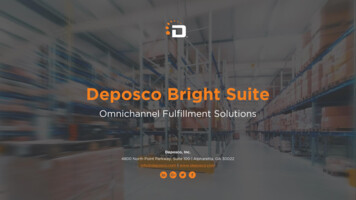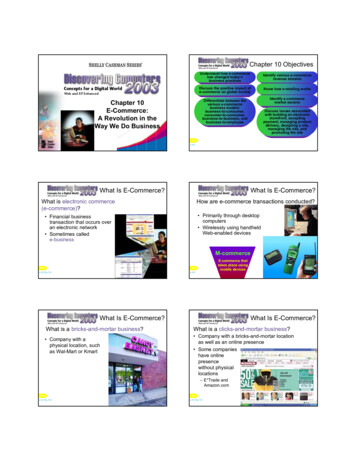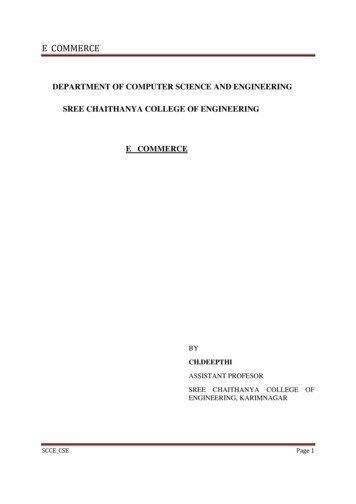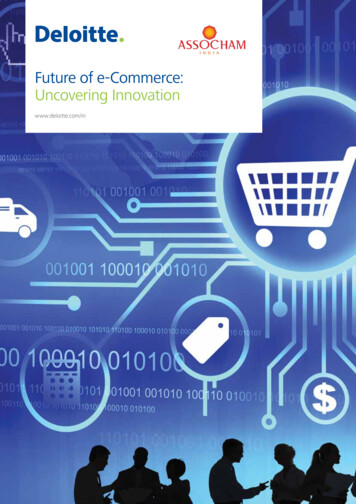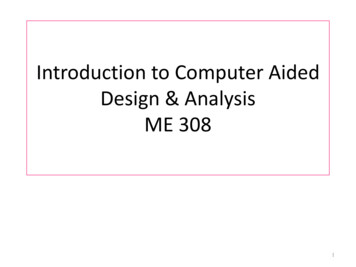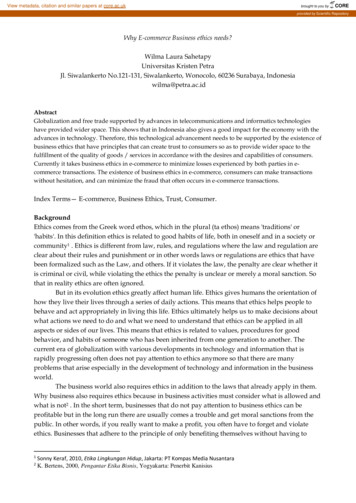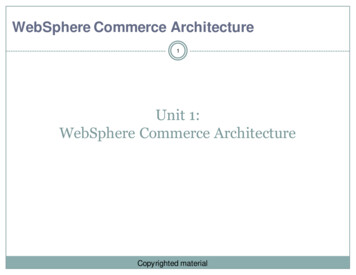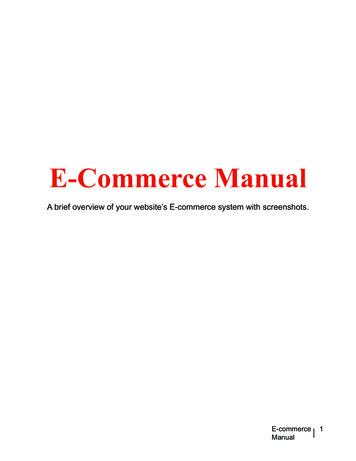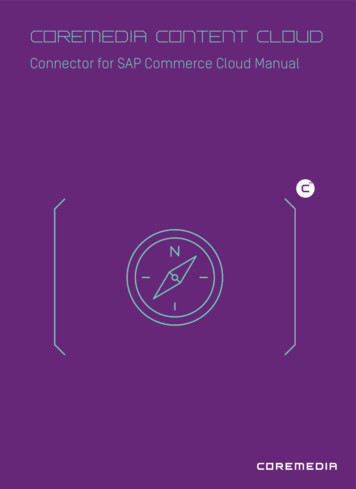
Transcription
Dr.P.RAMAR, M.Com., M.Phil., Ph.D.Dr.P.RAMAR1E-COMMERCE - nOTESUNIT-I:E-Business and E-Commerce: Introduction, Potential Benefits, Limitations,Classifications, Impact of E-Commerce on Business models. E-CommerceApplications: Entertainment, E-Marketing, E-Advertising, Search Engines, E-Banking,Mobile Commerce, Online Trading, ELearning, E-Shopping.UNIT-II:Architecture Framework of E-Commerce: Application Services, Brokerage and DataManagement, Interface layers, secure messaging, Middleware services and networkinfrastructure. Security Protocols: Open systems interconnection (OSI), TCP/IP, FTP,HTTP, SMTP, S-HTTP, SSL, NNTP, Messaging Protocols: Basic Mail Protocol,Security Enhanced Mail Protocol. Web Security Issues, Encryption Techniques:Symmetric and Asymmetric.UNIT-III:Consumer Oriented E-Commerce Applications, Mercantile Process Model: ConsumersPerspective and Merchant’s Perspective. Electronic Payment Systems: Advantages andrisks, Types of Payment System (Credit Cards, E-Cash, Smart-Cards).UNIT-IV:Electronic Data Interchange: Non EDI System, Partial EDI System, Fully IntegratedEDI System, Prerequisites for EDI. Issues of EDI: Legal issues, Security issues, Privacyissues.UNIT-V:E-Marketing Techniques: Search Engines, Directories, Registrations, Solicitedtargeted E-mails, Interactive sites, Banners, Advertising, Spam Mails, E-mail, Chainletters. Applications of 5P’s (Product, Price, Place, Promotion, People), EAdvertisingTechniques: Banners, Sponsorships, Portals, and Online Coupons.*****Page 1 of 35
Dr.P.RAMAR, M.Com., M.Phil., Ph.D.Dr.P.RAMAR2U IT-1Meaning of business:A business (also known as an enterprise or firm ) is an organization engaged in the tradeof goods , services , or both to consumers .Meaning of business:A general term that refers to any type of business activity on the internet, includingmarketing, branding, and research.Branding: - The process involved in creating a unique name and image for a product in theconsumer’s mind, mainly through advertising campaigns with a consistent theme.Commerce: - The buying and selling of products and services between firms, usually in differentstatus or countries.E-commerce: - e-commerce means buying and selling of products or services over electronicsystems such as the internet and other computer networks.Difference between E-business and E-commerce:In both cases , E stands for “Electronic networks “ and describes the applications ofElectronic network technology – including internet and electronic data interchange (EDI) – toimprove and change business process .E-commerce covers outward - facing processes that touch customers , suppliers andexternal partners , including sales , marketing , order taking , delivery , customer service , purchasingof raw materials ---.E-business includes E-commerce but also covers internal process such as production ,inventory management , products development , finance , human resources , E-business strategy ismore complex , productivity and cost savings .Ex:-E-bay, Amazon.Definition of E-commerce:OrWrite about E-commerce.E-commerce means buying and selling of products or services over Electronic systems such asinternet and other computer networks. This use of Electronic transmission medium (Tele communication) to Engage in theexchange, including buying and selling, of products and services either physically or digitally,from location to location. The key element of E-commerce is information processing. This information processing activity is in the form of business transactions. Some of the business transactions are :-Page 2 of 35
Dr.P.RAMAR, M.Com., M.Phil., Ph.D.Dr.P.RAMAR31. Transactions between company and the consumer over networks for the purpose ofhome shopping and home banking .2. Transactions between trading partners .3. Transactions for information distribution .2. Explain activities of E-commerce?a)Increasing the speed of service delivery.b)Use of computer networks to search and retrieve information in support of human andcorporate decision –making.c)Buying and selling of information, products and services via computer network.d)Faster customer response and improve services quality.e)Advertising on the internet.f)Online electronic commerce payments i.e., electronic funds transfer.3. Give some potential benefits of E-commerce.A. The most important feature s of E-commerce is1.The global nature of the technology.2.Low cost.3.Opportunity to reach hundreds of millions of people.4.Interactive nature.5.Variety of possibilities.6.Rapid growth of the supporting infrastructures.According to these features, E-commerce benefits are classified into 3 types. Benefits to organization. Benefits to consumers. Benefits to society.Benefits to organization:Following are the benefits of Ecommerce to organizations1.E-commerce expands the market place to national and international level.2.E-commerce decreases the cost of creating, processing, distributing, storing, andretrieving paper based information.3.Ability for creation highly specialized business.4.E-commerce reduces the time between the outlay of capital and the receipt of productsand services.5.E-commerce initiates business processes reengineering projects.Benefits to consumersThe following are the benefits of E-commerce to consumer1.E-commerce enables customer to shop or do \other transactions 24hrs a day, all yearround from almost any location.2.E-commerce provides customers with more choices they can select from many vendorsand from many products.3.In some cases, especially with digitized products E-commerce allows quick delivery.4.Customer can retrieve relevant and detailed information in seconds, rather than days orweeks .5.E-Commerce facilitates competition, which results in substantial discountsPage 3 of 35
Dr.P.RAMAR, M.Com., M.Phil., Ph.D.Dr.P.RAMAR46.E-Commerce allows consumers to interact with other customers and exchange ideas aswell as compare experiences.BENEFITS TO SOCIETY:The following are the benefits of E-Commerce to society:1.E-Commerce enables more individuals to work at home and to do less travelling forshopping resulting in less traffic on the roads and lower air pollution.2.E-Commerce enables people in rural areas to enjoy products and services that are notavailable to them. This includes opportunities to learn professions and earn college degrees.3.E-Commerce facilitates delivery of public services such as health care education anddistribution of Government social services at a reduced cost and or improved quality.CLASSIFICATIONS OF E-COMMERCE:EXPLAIN CLASSIFICATION OF E-COMMERCE.Ans: A common classification of E-Commerce is by the nature of transactions. Thereare six types of E-Commerce:1. BUSINESS - TO - BUSINESS (B2B): It includes the IOS transactions and electronicmarket transactions between organizations. IOS Transactions means Inter Organizational Information Systems refers to flow ofstandard transactions information between business partners, such as placing orders,building or paying.2. BUSINESS TO CUSTOMERS (B2C): These are retailing transactions withindividual shoppers.3. CUSTOMER TO CUSTOMER :In this transaction customer sells directly tocustomers example : selling residential properties, cars, etc.,4. NON BUSINESS E-COMMERCE: An increased no. of non-business institutions suchas academic institutions, not for profit institutions religious, organizations, socialorganizational activities.5. CUSTOMER TO BUSINESS (C2B): This category includes individuals who sellproducts are services to organizations.6. .INTRA BUSINESS E-COMMERCE: In this category includes all internalorganizational activities, usually preformed on intranets, that involves exchange ofgoods, services are information.4.What are the limitations of E-CommerceThe limitations of E-Commerce can be grouped into 1) Technical 2) Non-TechnicalCategories.Page 4 of 35
Dr.P.RAMAR, M.Com., M.Phil., Ph.D.Dr.P.RAMAR5Technical limitations of E-Commerce are1. There is a lack of system security, reliability, standards and some communicationprotocols.2. There is insufficient telecommunication band width.3. Soft ware development tools are changing rapidly.4. It is difficulty to integrate the internet and soft ware with some existing applicationdata basis.5. Some electronic commerce soft ware might not be fit without some network are may beincompatible with some operating systems or other components.NON-TECHNICAL LIMITATIONS:1. COST AND JUSTIFICATION: - The cost of developing E-Commerce in house is verycostly and made mistakes due to lack of experience may result in delays.2. SECURITY AND PRIVACY: - these issues are especially important in the B2C area,especially security issues which are privacy measures are constantly improved.ECIndustry has a very long and difficult task of convincing customers that onlinetransactions are secure and they will keep.3. Lack of trust and user resistance: - Customers do not trust on unknown faceless sellers,paperless transactions and electronic money.E-COMMERCE APPLICATIONS:EXPLAIN E-COMMERCE APPLICATIONS:ORExplain briefly applications of E-Commerce:Ans: Globally E-Commerce is applied in the following fields.1. E Marketing 2. E-Advertising 3. E-Banking 4. Mobile Commerce5. E-Learning 6. E-Shopping 7. Online training 8. Search Engines9. Entertainment1)E-MARKETING : E-Marketing also known as Internet marketing, Online marketing, Webmarketing. It is the marketing of products or services over the internet.It is consider to be broad in scope because not refers to marketing on the internet butalso done in Email and wireless media.E-Marketing ties together the creative and technical aspects of the internet, includingdesign development, advertising and sales.Internet marketing is associated with several business models ie., B2C, B2B, C2C.Internet marketing is inexpensive when examine the ratio of cost to the reach of thetarget.Page 5 of 35
Dr.P.RAMAR, M.Com., M.Phil., Ph.D.Dr.P.RAMAR62)E-ADVERTISING: It is also known as online advertising it is a form of promotion thatuses internet and world wide web to deliver marketing messages to attracts customers.Example: Banner ads, Social network advertising, online classified advertising etc.,The growth of these particular media attracts the attention of advertisers as a moreproductive source to bring in consumers.An online advertisement also offers various forms of animation.The term online advertisement comprises all sorts of banner advertisement, emailadvertising, in game advertising and key soon.3) E-BANKING OR INTERNET BANKING:Means any user with a personal computer and browser can get connected to his banks,website to perform any of the banking functions. In internet banking system the bank has acentralized data base i.e., web-enabled.Best example for E-Banking is ATM.An ATM is an electronic fund transfer terminal capable of handling cash deposits,transfer between ALCS, Balance enquiries, cash withdrawals, and pay bills.SERVICES THROUGH E-BANKING: Bill payment service.Fund TransferInvesting through internet BankingShoppingCustomers should never share personal information’s like pin nos., passwords, etc.,with any one.Through internet banking, you can check your transactions at any time of theday, and as many times as you want.4) MOBILE-COMMERCE: Mobile Commerce also known as M-Commerce, is the ability toconduct, commerce as a mobile device, such as mobile phone.SERVICES ARE:1. Mobile ticketing2. Mobile Vouchers, Coupons and3. Mobile contract purchase and delivery mainly consumes of the sale of ring tones,wallpapers and games of mobile phones.4. Local base servicesLocal discount offersLocal weather5. Information servicesPage 6 of 35
Dr.P.RAMAR, M.Com., M.Phil., Ph.D.Dr.P.RAMAR7NewsSports, Scores6.MOBILE BANKING: Banks and other financial institutions used mobile commerce to allowtheir customers to assess account information and make transactions, such as purchasing,withdrawals etc.,7. MOBILE BROWSING: Using a mobile browser- A www browser on mobile device customerscan shop online without having to be at their personal computer.5) E-LEARNING: E-Learning comprises all forms of electronically supported learning andteaching.E-Learning is essentially the computer and network-enabled transfer of skills and knowledge.E-Learning applications and processes include web-based learning, computer-based learning.Content is delivered via. The internet, intranet/extranet, audio, or video tape, satellite TV, andED-ROM.Computer-Based Learning, sometimes abbreviated to CBL, refers to the use of computers as akey component of the education environment.E-Learning is naturally suited to distance and flexible learning, but can also be usedconjunction with face-to-face teaching.E-Learning can also refer to the educational website such as those offering learning scenariosworst and interactive exercises for children.Communication technologies are used in E-Learning.A learning management system (LMS) is software used for delivering, tracking, and managingtraining /education.6) ONLINE SHOPPING:Online shopping is the process where by consumer directly buy goods or services from asell in real time, without an intermediary services over the internet .it is a form of EcommerceAn online shop, e-shop, e-store, internet shop web shop, web store, online store, orvirtual shop evokes the physical analogy of buying products or services in a shoppingcenter.The process is called business-to-consumer (B2C) online shopping. When a businessbuys from another business it is called business-to-business (B2B) online shopping.In order to shop online, one must be able to have access to a computer, a bank accountand debit card.Online shopping widened the target audience to men and women of the middle class.Online shoppers commonly use credit card to make payments , however some systemsenable users to create accounts and pay by alternative means ,such as1. Billing to mobile phones and landline.2. Cheque.3. Debit cards.4. Gift cards5. Postal money order.Online stores are usually available 24 hours a day, and many consumers have internetaccess both at work and at home.Online stores must describe products for sale with text, phones, and multimedia files .Page 7 of 35
Dr.P.RAMAR, M.Com., M.Phil., Ph.D.Dr.P.RAMAR8One advantage of shopping online is being able to quickly seek out deals for items orservices with many different vendors.Another major advantage for retailers is the ability to rapidly switch suppliers andvendors without disrupting users shopping experience.7) SEARCH ENGINE:A web search engine is designed to search for information on the WWW and FTP servers.The search results are generally presented in list of result and are often called hits.The information may consist of web pages, images, information, and other types of files.Some search engines also mine data available in database or open directories.Search engines work by storing information about many web pages, which they retrieve fromthe HTML it self.When a user enters a query into a search engine (typically by using keywords), the engineexamines its index and provides a listing of best matching according to its criteria.Most search engines support the use of Boolean operator AND, OR, and NOT.Some search engines, such as GOOGLE, store all or part of the source page as well asinformation about the web pages.8) ONLINE TRADING:An online trading community provides participants with a structured method for tradingbantering (exchanging goods with goods) or selling goods and services.These communities often have forums and chat rooms, designed to facilitate communicationbetween the members.A formal trading community consists of a website or network of websites that facilitates andtrack made transactions.While trading any used items online, be sure to include the condition and quality of theproduct so as the receiver can determine its overall value.A trading circle is a form of online trading design to facilitate viewing of television series andepisode media.9) ENTERTAINMENT:The conventional media that have been used for entertainment are1. Books/magazines.2. Radio.3. Television/films.4. Video games.The internet as an entertainment media is not a elastic by itself, but rather a unique interactionsof all of the above media.Computer based systems have been used as an entertainment medium in the form of videogames , CD , ROMs , etc.Online books /newspapers, online radio, online television, online firms, and online games arecommon place in internet where we can entertain.Online social networking websites are one of the biggest sources of E-entertainment for today’stech-savvy (who have knowledge interest in) generation.Page 8 of 35
Dr.P.RAMAR, M.Com., M.Phil., Ph.D.Dr.P.RAMAR9IMPACT OF COMPUTER TECHNOLOGY:THE ICDT MODEL:A model developed by ALBERT ANGETHRN called the information, communication,distribution; transaction (ICDT) model is used as a basis for discussing the internet strategy ALMARKETPLACEAngrhrn’s model is based on four virtual spaces1. Virtual information space :a) This space is where a firm displays information about their organization, products, orservices.b) This space is the easiest space for a business to enter and it is first step to enter into amarket place.For E-commerce major concerns are:i.The information that is displayed is accurate a current.ii.Customer can easily find the services and can reach the info easily.iii.The site is accessible without long wait.2. Virtual distribution space :i.This space is used to deliver the product or services requested or purchased by theconsumer.For E-commerce, major concerns areii.Delivery of products and services only the legitimate, approved customers.iii.Reliable delivery of products and services3. Virtual transaction space :This space is used to initiate and execute business transactions, such as sales orders.The major concern contributing to these reluctances is data security.Reliability of vendor.Reputability of trading partner.Page 9 of 35
Dr.P.RAMAR, M.Com., M.Phil., Ph.D.Dr.P.RAMAR10Privacy concern by customers.4. Virtual communication space :This space is used to enable relation-ship-building , negotiation ,and exchange of ideassuch as chat rooms , forums and communities .Three pillars of E-commerce:The three electronic pillars of E-commerce which support open market processes :1) Electronic information.2) Electronic relationship.3) Electronic transactions.1) Electronic information is similar to virtual information space . The WWW is viewed as a“global responsibility “, of documents and multimedia data , constructing an electronicinformation pillar is easy most word processing software packages will easily convert thedocuments into a web-readable format ,in the website , the web page does not freeze or linksdo not head the visitor to a dead end .2) Electronic relationships is the central pillar and this is similar to virtual communicationplacing information on products and services offer on a web site does not mean that potentialcustomer or guests will visit that web site again , once they are visited .3) The electronic transactions pillar is similar to virtual transactions space and also encompassesvirtual distribution space. Many business have built an electronic inf pillar and some have butor are building an electronic community pillar and fewer have constructed electronictransactions pillar.Two problems in constructing the pillar are:1) Engaging a meaningful sufficient, negotiable data.2) Keeping data transactions data secure.OPEN MARKETElectronicInformationElectronic acePage 10 of 35
Dr.P.RAMAR, M.Com., M.Phil., Ph.D.Dr.P.RAMAR11Short Question & Answers1) Define E-Business.2) Define E-commerce3) What are the potential benefits of E-commerce?4) What are the applications of E-commerce?5) Explain types of E-commerce.6) Explain limitations of E-commerce.7) Explain Define E-marketing, E-banking.8) Explain search engines & mobile commerce.Long Questions1) Explain benefits of E-commerce to organizations, consumers , society .2) Explain impact of E-commerce on business pedal.3) Explain ICDI model, three pillar of E-commerce.4) Explain termsE-Advertising.E-learning.E-shopping.Page 11 of 35
Dr.P.RAMAR, M.Com., M.Phil., Ph.D.Dr.P.RAMAR12U IT-3CONSUMER ORIENTED APPLICATIONSMECANTILE PROCESS MODEL: Mercantile process is an interaction model between consumer and Merchants for onlinecommerce. This is necessary to buy and sell goods, a buyer, a seller, and other parties should followsome standard business processes. The establishment of a common merchant process (or set off processes) is must toincrease the convenience for customers. A well established standard process using processing credit cards purchases contributedmore for the E-Commerce.There are three types of mercantile models. Mercantile models from the consumer’s perspectiveMercantile models from the merchant’s perspectiveMERCANTILE MODELS FROM THE CONSUMER’S PERSPECTIVE:The online consumer expects quality, convenience, value, low price and control.To meet these expectations, the business process model from consumer’s perspectivegrouped seven activities into 3 phases.Seven activities are1)Product / service search2)Product selection3)Negotiations of terms1)Pre-purchasedetermination4) Placement of order5)Authorization of payment6)Receipt for payment2)Purchasesconsumption7)Customer service and support3)Post purchaseinteractionPage 12 of 35
Dr.P.RAMAR, M.Com., M.Phil., Ph.D.Dr.P.RAMAR13PRE-PURCHASE DETERMINATION:It includes search and discovery for a set of products in the large information space capable ofmeeting customer requirement and product selection from the smaller set of products based onattribute (characteristics) comparison.Consumers have to watch for a new or existing information regarding variables that are importantfor the purchase decision process.Customers are of 3 types.1) Impulsive buyers:- Who purchase products quickly.2) Patient buyers:- Who purchase products after making comparison.3) Analytical buyer:- Who do substantial research before making the decision topurchase products or services.In the context of E-Commerce, information search can be classified into 2 categories.1) Organizational search2) Consumer search1. ORGANISATIONAL SEARCH: It is an activity designed to balance the cost of acquiring information with thebenefits of improved final decisions.As time to time changes information regarding product may be relatively lessvaluable, so firm or organization respond to high-paud information change byconstraining search process2. CONSUMER SEARCH:Consumer search are categorized into 2 types. Utilitarian means task related and relational, implying that a product is purchased inefficient manner. Hedonic value means for fun sake and playfulness, does not complete the task.In facilitating better consumer satisfaction and organizational search, intermediaries calledinformation brokers or brokerages. Information brokerages are needed for 3 reasons. Comparison shopping Reduced search costs IntegrationPURCHASE CONSUMATION: After identifying the products to be purchased, the buyer and seller must interact to carryoutmercantile transaction.Page 13 of 35
Dr.P.RAMAR, M.Com., M.Phil., Ph.D.Dr.P.RAMAR14 A mercantile transaction is defined as the exchange of information between buyer and sellerfollowed by the payment.Depending on the payment model mutually agreed on, they may interact by E-Cash, ortransferring authorization for credit billing authorization (Visa, Master Cards)Mercantile process using digital cash or E-Cash.Mercantile process using credit cards.Basic mercantile process model for any transaction online business.Basic Mercantile process model for any transaction online business.1)2)3)4)Buyer contact vender to purchase product, through WWW, Email, Telephone etc.Vender states priceBuyer and vender may or may not engage in negotiation.If satisfy, a buyer authorized payment to the vendor with an encrypted transaction for theagreed price.5) Vendor contacts his or her billing service to verify the encrypted authorization forauthentication.6) Billing service decrypts authorization and check buyer’s account balance and put hold on theamount of transfer7) Billing service gives the vendor the ‘green light’ to deliver products and sends a standardizemessage giving details of transactions for merchants records.8) On notification of adequate funds to cover financial transactions, vendor delivers the goods tobuyers.9) On receiving the goods the buyers signs and delivers receipt. Vendor tells billing service tocomplete the transactions.10)All the end of billing cycle, buyer receive a transactions.MERCANTILE PROCESS USING DIGITAL CASH OR E-CASH:E-Cash in similar to paper currency and has more benefits and easily transmitted electronically.The following are the mercantile protocol based on the use of e-cash.1. Buyer obtains anonymous (secret) e-cash from issuing bank.2. Buyer contacts seller to purchase product.3. Seller states the price.4. Buyer sends e-cash to seller.5. Seller contacts his bank or billing Service to verify the validity of the e-cash.6. Bank gives o.k. signal to seller.7. Seller delivers the product to buyer.Page 14 of 35
Dr.P.RAMAR, M.Com., M.Phil., Ph.D.Dr.P.RAMAR158. Seller then tell bank to mark the e-cash asMERCANTILE TRANSACTIONS USING CREDIT CARDS:Two major components comprise credit card transactions in the mercantile process: ElectronicAuthorization and Settlement credit authorization processes at point-of-sale terminal. The creditcard number is checked against the database and the transaction is either approved or denied, withinfew seconds.Step-by-step a/c of a retail transaction follows:Step 1: A customer presents a credit card for payment at a retails location.Step 2: The point-of-sale s/w directs the transaction of to the Local Network access point.Step 3: The system verifies the source of the transactions and routes to the appropriate authorizationsource.Step 4: At retail location collects all complement transaction information into a ‘batch’.Step 5: The system gathers all completed transactions and processes the data in preparation forsettlement.Post purchase interaction:This includes customer service and support to address customer complaints, product returns andproduct defects.: - Inventory Issues.: - Database Access.MERCANTILE MODELS FROM THE MERCHANTS PERSPECTIVEThe Order to delivery cycle from the Merchant’s perspective has been managed with anstandardization & cost.To fully realize and maintain a competitive advantage in the on-line environment, a company mustbuild a robust vision of “order-to-delivery” cycle. This lads to a another cycle “Order ManagementCycle” (OMC) .OMC includes eight distinct activities.: - Order planning & Order generation.: - Cost estimation & Pricing.: - Order Receipt & Entry.: - Order selection & prioritization.: - Order scheduling.Page 15 of 35
Dr.P.RAMAR, M.Com., M.Phil., Ph.D.Dr.P.RAMAR16: - Order fulfillment & Delivery.: - Order Billing & A/C payment management.: - Order Service & Support.Order Planning & Order Generation: The Business process begins with an actual order of placed by the customers.Order planning leads to the order generation order generated in sending personalized e-mailto customer (cold calls), Create WWW page.Cost estimation & pricing:-Pricing is the bridge between customers’ needs and company capabilities.-Pricing at the individual order level depends on an understanding the value to the customers thatis generated by each orders.- Evaluating the cost of filling each order.Order Receipt & Entry:After acceptable price, the customers enter the order receipt and entry phase of OMC.These orders are taken by customer service representatives, who are in constant contract withcustomers.Order Selection & Prioritization:Customer service representatives are responsible for choosing which orders to accept and which todecline.* Not all customer orders are created equal.*The desirable orders are those that fit the company’s capabilities and gives good profit.*Companies can make gains by the way they handle order prioritization- i.e decide which orders toexecute faster.Order scheduling:During the order scheduling phase the prioritization orders get slotted into an actual production oroperation sequence.This task is will become difficult because of the different departments having conflating goals.Order fulfillment and Delivery.During this phase the actual product or service is delivered.*Order fulfillment involves multiple function & Locations.*In some business, fulfillment includes third party vendors.Order Billing and Account Payment:Page 16 of 35
Dr.P.RAMAR, M.Com., M.Phil., Ph.D.Dr.P.RAMAR17After the order has been fulfilled and delivers billing is typically handled by the finance department.This department gets the bill out effectively efficiently and close collect very quickly.Customer Service & Support:Customer service involves installation of a product, repair maintenance.This service gives customer satisfaction company profitable year.Electronic Payment Systems:Definition: Electronic payment is a financial exchange that takes place online between buyers andsellers. The content of this exchange is usually as encrypted credit card numbers, electronic chequesor cash. The various factors that have had the financial intuitions to make use of electronic paymentsare:1. Decreased technology cost. Interest is becoming free almost everywhere in the world.2. Reduced operational and proceeding cost.3. Increasing online commerce.Advantages:1. Privacy.2. Integrity.3. Compatibility.4. Good transaction efficiency.5. Acceptability.6. Convenience.7. Mobility.8. Low financial risk.9. Anonymity.1) The greatest advantage of e-payments is the convenience. I.e. customer can pay on one from anylocations 24 hours day, 7 days a week.2) E-payments have reduced the amount of time s
2. E-commerce decreases the cost of creating, processing, distributing, storing, and retrieving paper based information. 3. Ability for creation highly specialized business. 4. E-commerce reduces the time between the outlay of capital and the receipt of products and services. 5. E-commerce initiates business processes reengineering projects.
